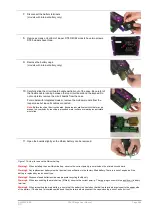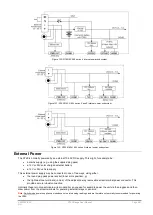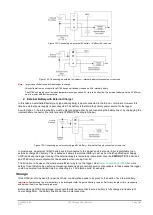
UM-0085-B09
DT80 Range User Manual
Page 288
RG
Internal Power
not applicable to DT82E/ 80L/ 85L/ 85GL
If the external power supply is interrupted, the DT80 can run for a limited time on battery power.
Main battery
The DT80 and DT81/82I are fitted with an internal
6V 1.2Ah
sealed lead-acid gel-cell battery, while the DT85 uses a
higher capacity
6V 4Ah
battery. It’s known as the
DT80
’s "main" battery to distinguish it from the
DT80
’s other internal
battery, the "memory-backup" battery.
The main battery is completely maintenance-free and rechargeable, being automatically charged by the logger’s inbuilt
battery charger whenever an external power supply is connected to the
DT80
. If properly cared for (which essentially
means keeping it charged), the battery should give several years' service.
Note1:
The DT80G does not include an internal battery. It does, however, include the battery charger circuit so an external lead acid
battery can easily be connected; see
Connecting a Larger Battery (P288)
.
Note2:
The battery's life will be reduced if operated at temperatures exceeding 50°C.
If the main battery ever needs to be replaced,
explains how to do so.
Connect the Battery Link
The
DT80
is shipped with the main battery disconnected.
To connect the battery, all you need to do is plug the supplied 4-way terminal block into the power connector on the side
of the
DT80
. The supplied terminal block includes a link which connects the
B
and
C
terminals on the power connector.
This will connect up the internal battery to the
DT80
circuitry.
It is recommended that the battery link be left permanently attached to the
DT80
during operation. This guarantees
uninterrupted data acquisition and logging because the internal main battery is always available to continue powering the
data logger if the primary/external supply is accidentally disconnected or fails.
Main Battery Life
The length of time that the
DT80
can operate using its internal battery depends on many things, such as:
•
scan interval
•
number and types of channels being scanned
•
volume of RS232/USB/Ethernet communications
•
power management settings (e.g. sleep mode timeouts)
•
sensor excitation requirements
•
condition of internal battery and ambient temperature
For the DT80/82I (1.2Ah internal battery), a new, fully charged battery will typically run the logger for between 3 and 3000
hours (4 months), depending on the above factors. The DT85's power consumption is similar to the DT80/81/82I, so its
4Ah battery can be expected to last 3-4 times longer.
The scan interval is the main determinant of battery life. For a continuous schedule with some analog channels, the
battery life would typically be about 3 hours; for a 5 second schedule it would be about 24 hours; while for sample
intervals of 1 hour or greater the battery would typically last for up to 4 months. In order to properly estimate the expected
battery life, it is necessary to calculate the
DT80
's average power consumption for the particular application. This is
.
Connecting a Larger Battery
To extend the time that the
DT80
can run whilst on battery power, a larger capacity battery can be connected externally.
(This is also applicable for the DT80G, which does not include an internal battery.) There are two main options, which are
discussed below.
1. External Battery Charged by Logger
An external
6V lead acid
battery (max capacity
4Ah
) may be connected between the
C
and
–
terminals. This will
connect the battery to the output of the
DT80's
charging circuit. An external power supply should then be connected to
the
+
and
–
terminals (or DC power socket). To prevent excessive current flows between the batteries, the internal
battery should always be disconnected from the charging circuit when an external 6V battery is used. This can be
achieved either by:
•
not connecting the battery link between the
B
and
C
terminals
, or
•
connecting the link between the
B
and
C
terminals but disconnecting the internal battery connector
. If desired the internal battery can then be removed altogether. This is the preferred option because then
the
VBAT
channel type can be used to monitor the state of the external battery; see
.
















































